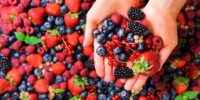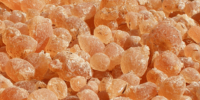Prebiotic Type Spotlight: Inulin
Last updated February 2024
Each edition of GPA’s Prebiotic Spotlight focuses on a specific prebiotic type to raise awareness around the prebiotic itself, its sources, any notable and/or recent research, and how it is used in the marketplace. In this issue, inulin is highlighted.
Overview
Inulin is a naturally occurring, water-soluble, storage polysaccharide that belongs to a group of non-digestible carbohydrates called fructans (Shoaib et al., 2016; Teferra, 2021). The structural composition of inulin consists of linear D-fructose units with β (21) linkages and one terminal glucose molecule with α (12) linkage (Ahmed & Rashid, 2019; Teferra, 2021; Perinelli, 2023). Inulin is innately found in over 36,000 plant species; however, it is primarily abundant in chicory root, dahlia, and Jerusalem artichoke (Niness, 1999; Shoaib et al., 2016; Gupta et al., 2019). Widely used as a prebiotic, fat and sugar replacer, and food texture modifier, inulin is often used in the development of functional foods due to its health benefits and technical properties (Shoaib et al., 2016). In the human body, inulin is not readily digested, fermented, or absorbed in the initial gastrointestinal tract, but is instead digested in the distal portion of the colon by pulling in water, managing constipation, and promoting the growth of colonic microbiota (Shoaib et al., 2016; Gupta et al., 2019). These properties make inulin a soluble dietary fiber and efficient prebiotic.
Benefit Areas
Inulin is a prebiotic fiber that has been extensively studied throughout the past few centuries and researched for its many health benefits, including:
- Stimulating the growth of healthy gut microorganisms, such as Bifidobacterium, Lactobacillus, and Faecalibacterium prausnitzii, and inhibiting the growth of harmful bacteria, such as Escherichia coli, Campylobacter jejuni, Salmonella enterica, and Clostridium perfringens (Ahmed & Rashid, 2019; Hughes et al., 2019; Teferra, 2021).
- Stimulating the immune system by having a positive impact on gut-associated lymphoid tissues (Ahmed & Rashid, 2019; Hughes et al., 2019; Teferra, 2021).
- Improving cardiovascular health by reducing blood glucose, plasma lipid and cholesterol levels, as well as decreasing triglycerides and improving lipid profile and blood pressure (Ahmed & Rashid, 2019; Hughes et al., 2019; Teferra, 2021).
- Protecting the colon mucosa against carcinogenesis and inflammation (Teferra, 2021; Kono et al., 2023).
- Increasing insulin sensitivity by slowing down glucose absorption, stabilizing glycemic response, and absorbing bile salts from the small intestine (Ahmed & Rashid, 2019; Hughes et al., 2019).
- Improving laxation by increasing stool size, frequency, and improving intestinal health by providing relief from constipation (Ahmed & Rashid, 2019; Hughes et al., 2019).
- Increasing absorption of calcium and magnesium contributing to bone health (Hughes et al., 2019).
- Increasing satiety and supporting weight management (Hughes et al., 2019).
Sources
Inulin was first discovered in the early 1800s from the roots of an Inula helenium plant by the German scientist, Valentine Rose, and was later termed “inulin” by Thomson in 1817 (Shoaib et al., 2016; Ahmed & Rashid, 2019; Teferra, 2021). In 1864, plant physiologist, Julius Sachs, was the first person to examine inulin under a microscope and discovered its spherocrystalline structure (Shoaib et al., 2016; Ahmed & Rashid, 2019; Teferra, 2021). Commonly consumed plants including onion, leek, garlic, banana, wheat, rye, and barley provide a considerable amount of inulin in the average human diet; however, the major vegetation sources used for the commercial production of inulin include tubers of dahlia, Jerusalem artichoke, roots of chicory, and yacon, due to their significantly higher inulin content (Meskink et al., 2015; Teferra, 2021). Inulin is produced via three major processes: extraction, purification, and drying (Teferra, 2021). The technical properties of inulin make it a desirable ingredient for various food applications. Inulin is classified as a food or food ingredient, and not an additive, in all European Union countries and has been legally labelled as a dietary fiber (Ahmed & Rashid, 2019). Inulin sourced from agave, artichoke, and chicory is Generally Recognized As Safe (GRAS) by the United States (US) Food and Drug Administration (FDA) for use as a general-purpose food ingredient, bulking agent, sweetener, texturizing agent, sugar and fat replacer, and/or humectant in various food categories and infant formulas (US FDA, 2023). In Canada, inulin sourced from agave, burdock, chicory, artichoke, and dandelion is permitted for use as a medicinal and non-medicinal ingredient in Natural Health Products (NHPs) under the Natural Health Products Regulations, in addition to being assessed as a non-novel food by Health Canada’s Food Directorate (Health Canada, 2023a; Health Canada, 2023b). Health Canada has published a monograph defining pre-cleared safety and efficacy evidence for inulin as an NHP, which accepts inulin for use as a prebiotic, source of fiber, healthy digestive system aid, and constipation relief (Health Canada, 2023c).
Dose Range
Daily inulin intakes have been estimated to be 1 – 10 g per day in the Western diet, with averages of 1.3 – 3.5 g and 3 – 11 g per day for typical American and European diets, respectively (Mensink et al., 2015; Teferra, 2021). The following dose ranges have been established as GRAS by the US FDA:
- 1 g per serving in infant and toddler foods.
- 5 g per serving in ready-to-eat breakfast cereals.
- 5 – 15 g per 100 g in all other foods.
- 25 g per serving in powdered form.
- 35 g per serving in syrup form.
- 42% by weight in bakery products, beverages, cereals and other grain products, dairy products and dairy substitutes, desserts, snacks, and soups.
Health Canada’s Inulin Monograph lists acceptable dosages of inulin for oral use as 2 – 15 g of inulin per day. According to the Natural Medicines Database (2023), inulin is proven safe for oral use at doses of 8 to 18 g per day for six months and up to 30 g per day for one month. Oral consumption of more than 30 g of inulin per day has been associated with flatulence, bloating, diarrhea, constipation, and gastrointestinal cramps.
Recent Research
There are 46 studies actively recruiting on ClinicalTrials.gov, using inulin for treatment in type 1 diabetes, chronic kidney disease, pediatric epilepsy, polycystic ovarian syndrome, and other conditions (ClinicalTrials.gov, 2023). Moreover, searching “inulin” on the PubMed database retrieved 358 articles published in 2023, with ten of them being randomized controlled trials (RCTs) studying several conditions, including obesity and depression, peritoneal dialysis, chronic kidney disease, and appetite and satiety (PubMed, 2023).
A 10-week double-blind RCT conducted by Aldubayan et al. (2023) investigated the impact of a high fiber plant-based diet consumed with or without added inulin-type fructans (20 g per day of inulin and its hydrolyzed form, fructooligosaccharide, extracted from chicory root) on the gut microbiota composition and cardiometabolic benefits in 82 participants, aged 18 – 65 years, with obesity. They found that all subjects that completed the study lost weight and experienced significant improvements in body composition and cardiometabolic health indices. Participants who were administered the inulin-type fructan supplemented diet experienced and selectively increased Bifidobacterium and Faecalibacterium levels, as well as higher values of insulin and lower high-density lipoprotein cholesterol.
An in vitro analysis completed by Kono et al. (2023) investigated the ability of dietary fibers and indigestible oligosaccharides to protect the intestinal barrier from inflammation-induced damage in the elderly. They conducted this assessment by culturing dextrin, inulin, partially hydrolyzed guar gum (PHGG), lactulose, raffinose, and alginate using a pH-controlled fermentation system with samples of feces collected from elderly volunteers. It was observed that inulin and PHGG-derived supernatants had a protective impact on the intestinal barrier by accelerating the production of short chain fatty acids (SCFAs) and modifying intestinal barrier function-related gene expression levels.
A study conducted by Perinelli et al. (2023) developed an Italian fresh cheese, “giuncata”, enriched with 4% w/w inulin. They determined that the addition of inulin had no effect on the pH of the cheese, did not influence the cheese’s appearance or mechanical properties, and did not impact the fat content. A slight “softening effect” was observed in the inulin-fortified cheese compared to the control. This study concluded that an industrial scale-up in the production of functionally inulin-fortified cheese would be feasible and useful in providing inulin-fortified products.
How is inulin used in the marketplace?
Inulin is a versatile prebiotic and dietary fiber that has been incorporated into a variety of different foods such as bakery products, cereal and grain products, dairy and dairy substitute products, desserts, and snacks throughout Europe, US, Canada, Australia, New Zealand, Japan, and many other countries. Inulin is valued for the technical properties it can provide to a food product, i.e., sweetening agent, humectant, bulking agent, etc., as well as for the health benefits that it has proven to exhibit. The exceptional health claims attributed to inulin make it an advantageous ingredient for supplements and nutraceutical products. According to Future Market Insights (2022), the agave inulin market is estimated to reach $3.5 billion USD in 2032, a 4.6% compound annual growth rate (CAGR) from the valuated $2.2 billion USD in 2022. This is driven by consumers looking for an alternative to sugar and wanting a product that contributes to their overall health and well-being.
References:
Ahmed, W. & Rashid, S. (2019). Functional and therapeutic potential of inulin: A comprehensive review. Critical Reviews in Food Science and Nutrition, 59(1):1-13. https://doi.org/10.1080/10408398.2017.1355775
Aldubayan, M.A., Mao, X., Laursen, M.F., Pigsborg, K., Christensen, L.H., Roager, H.M., Nielsen, D.S., Hjorth, M.F., & Magkos, F. (2023). Supplementation with inulin-type fructans affects gut microbiota and attenuates some of the cardiometabolic benefits of a plant-based diet in individuals with overweight or obesity. Frontiers in Nutrition, 10. https://doi.org/10.3389/fnut.2023.1108088
ClinicalTrials.gov. Retrieved on 2023 Sep 22. Available from: https://clinicaltrials.gov/search?term=Inulin&aggFilters=status:rec
Future Market Insights. Agave Inulin Market Outlook (2022 to 2032). Retrieved on 2023 Nov 01. Available from: https://www.futuremarketinsights.com/reports/agave-inulin-market
Gupta, N., Jangid, A. K., Pooja, D., & Kulhari, H. (2019). Inulin: A novel and stretchy polysaccharide tool for biomedical and nutritional applications. International Journal of Biological Macromolecules, 132:852-863. https://doi.org/10.1016/j.ijbiomac.2019.03.188
Health Canada a. NHPID: Inulin. Retrieved on 2023 Oct 31. Available from: https://webprod.hc-sc.gc.ca/nhpid-bdipsn/ingredReq.do?id=1527&lang=en
Health Canada b. List of non-novel determinations for food and food ingredients. Retrieved on 2023 Oct 31. Available from: https://www.canada.ca/en/health-canada/services/food-nutrition/genetically-modified-foods-other-novel-foods/requesting-novelty-determination/list-non-novel-determinations.html#wb-auto-4
Health Canda c. Inulin monograph. Retrieved on 2023 Oct 31. Available from: https://webprod.hc-sc.gc.ca/nhpid-bdipsn/atReq.do?atid=inuline&lang=eng
Hughes, R.L., Alvarado, D.A., Swanson, K.S., & Holscher, H.D. (2022). The prebiotic potential of inulin-type fructans: A systematic review. Advances in Nutrition, 13(2):492-529. https://doi.org/10.1093/advances/nmab119
Kono, G., Yoshida, K., Kokubo, E., Ikeda, M., Matsubara, T., Koyama, T., Iwamoto, H., & Miyaji, K. (2023). Fermentation supernatant of elderly feces with inulin and partially hydrolyzed guar gum maintains the barrier of inflammation-induced Caco-2/HT29-MTX-E12 co-cultured cells. Journal of Agricultural and Food Chemistry, 71(3):1510-1517. https://doi.org/10.1021/acs.jafc.2c06232
Mensink, M.A., Frijlink, H.W., van der Voort Maarschalk, K., Hinrichs, W.L.J. (2015). Inulin, a flexible oligosaccharide I: Review of its physicochemical characteristics. Carbohydrate Polymers,
130:405-419. https://doi.org/10.1016/j.carbpol.2015.05.026
Natural Medicines Database. Inulin. Retrieved on 2023 Oct 31. Available from: https://naturalmedicines.therapeuticresearch.com/databases/food,-herbs-supplements/professional.aspx?productid=1048#dosing
Niness, K.R. (1999). Inulin and oligofructose: What are they? The Journal of Nutrition, 129(7):1402S-1406S. https://doi.org/10.1093/jn/129.7.1402S
HarPerinelli, D.R., Santanatoglia, A., Caprioli, G., Bonacucina, G., Vittori, S., Maggi, F., & Sagratini, G. (2023). Inulin functionalized “giuncata” cheese as a source of prebiotic fibers. Foods, 12(18):3499. https://doi.org/10.3390/foods12183499
PubMed. Inulin. Retrieved on 2023 Oct 31. Available from: https://pubmed.ncbi.nlm.nih.gov/?term=inulin&filter=years.2023-2023
Shoaib, M., Shehzad, A., Omar, M., Rakha, A., Raza, H., Sharif, H.R., Shakeel, A., Ansari, A., & Niazi, S. (2016). Inulin: Properties, health benefits and food applications. Carbohydrate Polymers, 147:444-454. https://doi.org/10.1016/j.carbpol.2016.04.020
Teferra, T.F. (2021). Possible actions of inulin as prebiotic polysaccharide: A review. Food Frontiers, 2:407-416. https://doi.org/10.1002/fft2.92
US FDA. GRAS Notices. Inulin. Retrieved on 2023 Oct 31. Available from: https://www.cfsanappsexternal.fda.gov/scripts/fdcc/?set=GRASNotices&sort=GRN_No&order=DESC&startrow=1&type=basic&search=inulin




